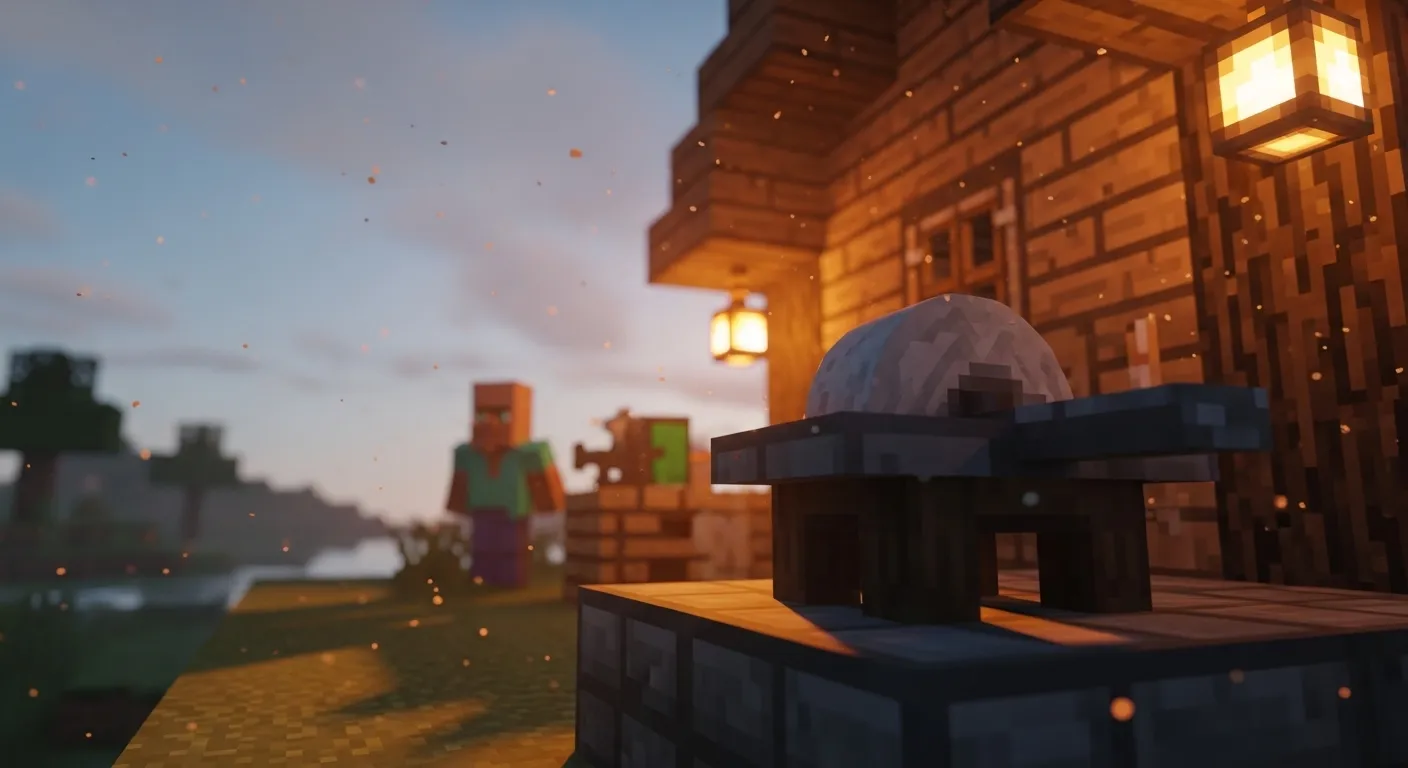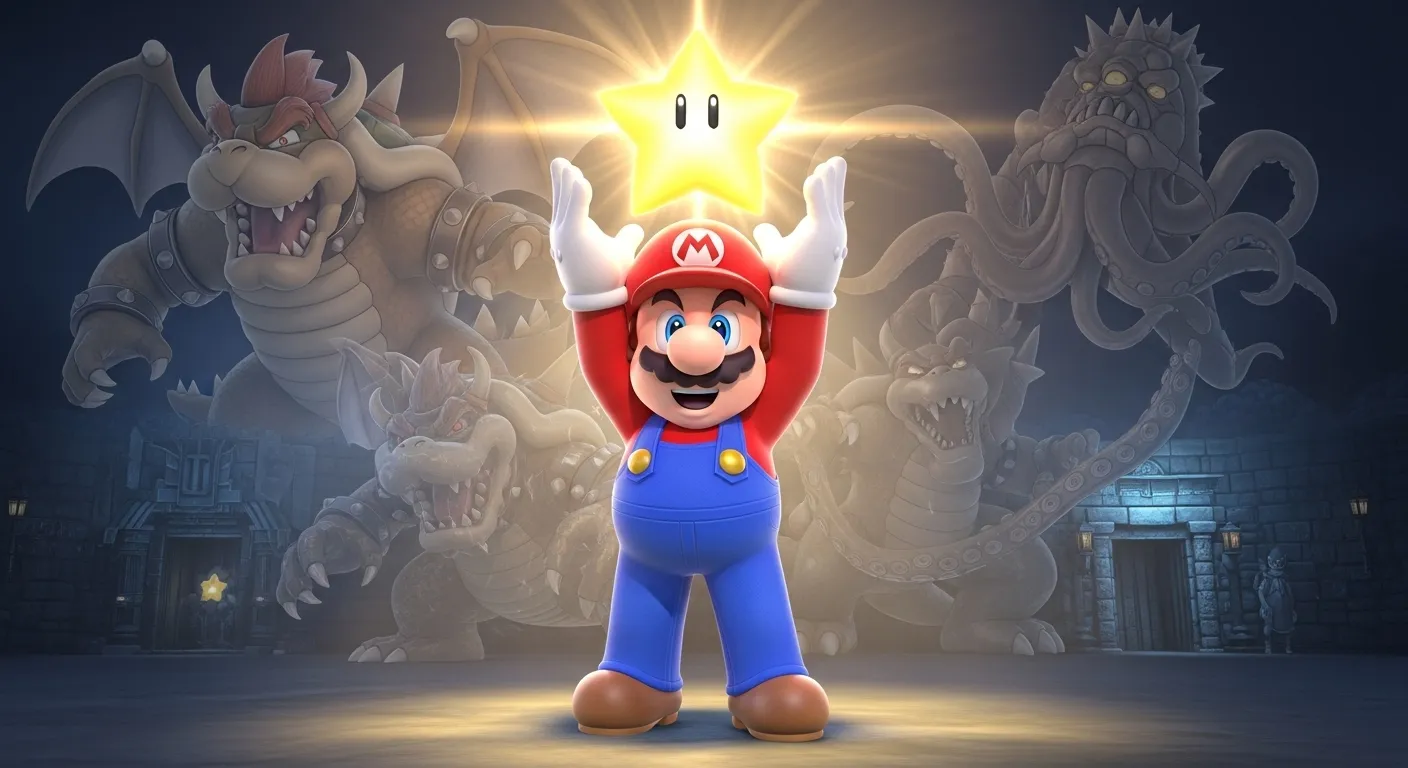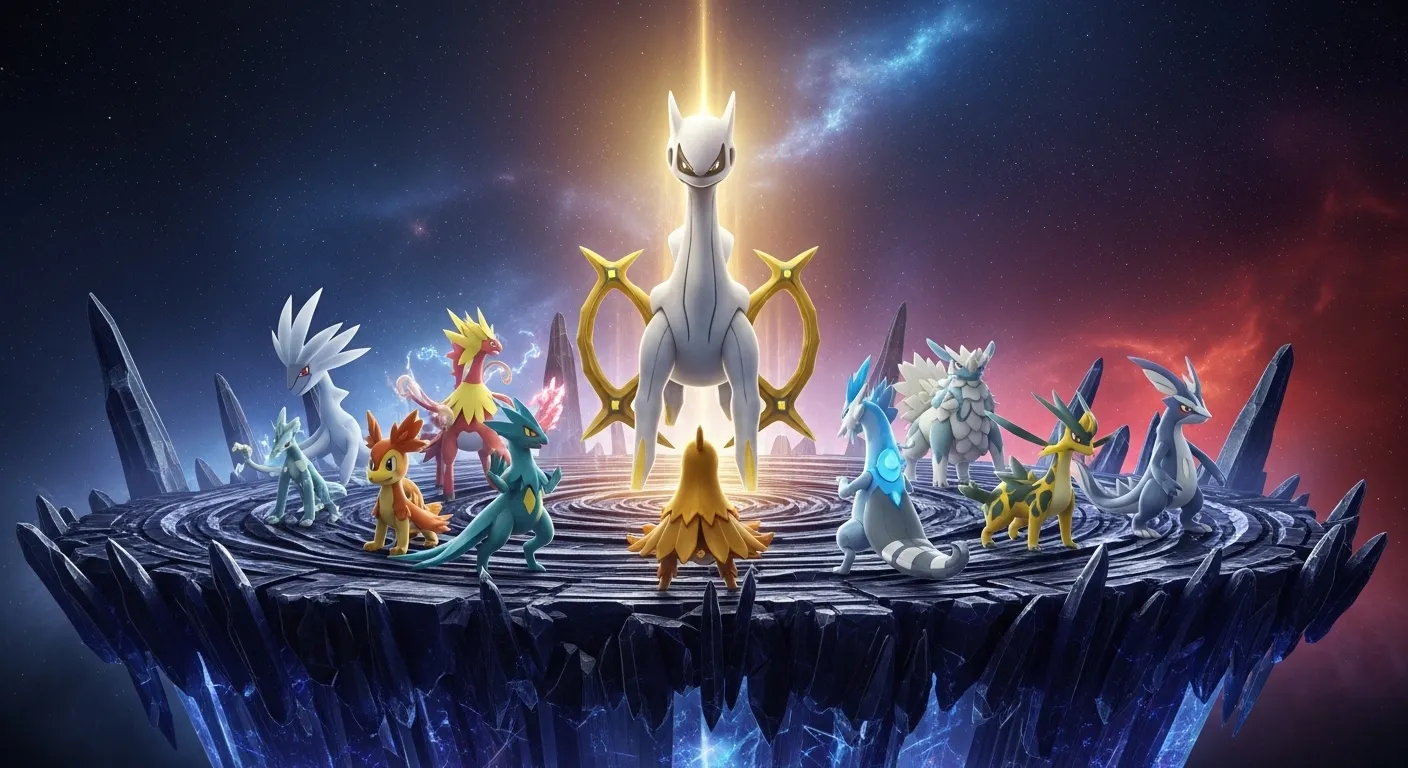Sometimes you don’t want to spend half an hour digging through wikis or watching someone speed-run explanations at 200 mph just to figure out a simple grindstone recipe. If you’re anything like me, you probably just want the steps, the reasons, and maybe a few weird side notes people overlook. So, here we go, a casual dive into the grindstone Minecraft recipe, what it needs, how to use it, and the stuff that usually catches new players off guard.
Before anything else: yes, the main keyword grindstone recipe is right here in the first breath so we’re good on SEO. And the article isn’t going to feel like it was scrubbed until it shines. More like someone who knows Minecraft too well talking after a long building session.

What Even Is a Grindstone? (Quick Reality Check)
If you’ve never crafted one before, the grindstone recipe creates something that looks a bit like two wooden legs holding up a circular stone wheel — basically the kind of thing villagers might use if they actually had hands. In Minecraft, the grindstone is the tool you use to repair gear and remove enchantments without getting too fancy. It’s simple. Functional. Kind of underrated, honestly.
The grindstone sits somewhere between early-game necessity and mid-game utility. It doesn’t have the prestige of an anvil, but once you learn the grindstone recipe and start dealing with enchanted loot filled with questionable enchant combos, yeah, the grindstone quickly becomes your cleanup crew. If you want deeper guides similar to this, you can check out more walkthroughs here → walkthroughs.

Grindstone Crafting Recipe: The Basics
Let’s get into the heart of it: how to craft a grindstone without overthinking.
Here’s the short version:
You need:
- 2 Sticks
- 2 Wooden Planks (any type)
- 1 Stone Slab
And yeah, that’s it. Not a smooth stone slab. Not cobblestone slab. Just a stone slab, which means you’ve gotta smelt cobblestone first.
Table: Grindstone Materials Needed
| Material | Quantity | Notes |
| Sticks | 2 | Crafted from planks |
| Wooden Planks | 2 | Any wood type works |
| Stone Slab | 1 | Must be stone, not cobble |
You’ll throw these into a crafting table in a very specific pattern. It’s one of those crafting table recipes that looks more complicated than it really is.
Grindstone Minecraft Recipe Layout
Here’s the placement (3×3 grid):
- Top Row: Stick, Stone Slab, Stick
- Middle Row: Plank, (empty), Plank
- Bottom Row: empty
Yes, it really is that awkward. But once you’ve done it once, it locks itself in your brain.
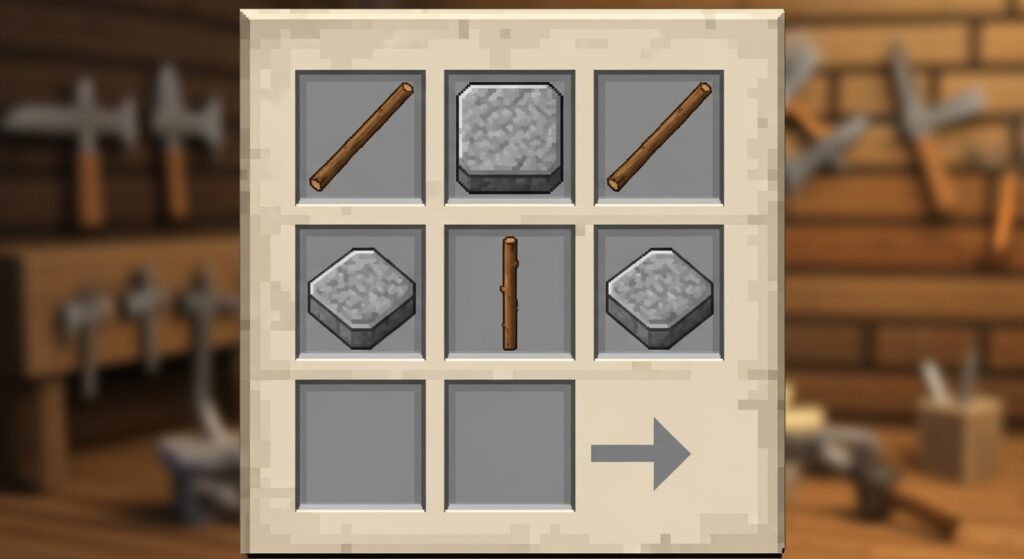
Grindstone Ingredients & Where to Get Them
Let’s break down the grindstone ingredients like you’re starting from scratch on a new world. Sometimes you don’t have all the materials on hand, and Minecraft loves to make you wander for the simple stuff. If you ever need extra help with similar mechanics or gameplay steps, you can dive into more detailed walkthroughs here → walkthroughs.
Sticks:
You know the drill, chop a tree, turn planks into sticks. Nothing new here.
Wooden Planks:
Oak, spruce, birch, jungle, mangrove, whatever. Any will do. Minecraft isn’t picky. Well… not about this, anyway.
Stone Slab:
This is the part that catches beginners: You need stone, not cobblestone.
Meaning:
- Mine cobblestone
- Smelt cobblestone into stone
- Put 3 stone blocks in a horizontal line in the crafting table to get a stone slab
That’s the grindstone requirements in a nutshell.
Grindstone Placement: Do It Right
You can put a grindstone pretty much anywhere, but there are a few things worth knowing.
- It’s directional, meaning it faces you when you place it.
- Villagers can turn into Weaponsmiths if they see one nearby.
- It’s best placed near your anvil, repair area, or storage chests.
I’ve seen players place a grindstone in the weirdest spots—buried halfway in walls, stuck in corners, or even hanging from ceilings like a bat. You can do it, sure, but it always looks a bit off. The legs point downward, so even if you already know the grindstone recipe, it’s definitely not meant for ceiling décor.
Also, remember that the grindstone doubles as a villager job-site block. If you’ve got loose villagers wandering around your base, crafting and placing anything from the grindstone recipe might suddenly convince one of them to become a Weaponsmith. Happens more often than you’d expect. And if you enjoy breaking down game mechanics or hidden powers in a similar storytelling style, you might like this take on One Piece’s Loki secret power → Loki secret power.
For players who are still learning the basics or refining their builds, especially when working with stone-related blocks, this guide on making smooth stone comes in handy → how to make smooth stone in Minecraft.
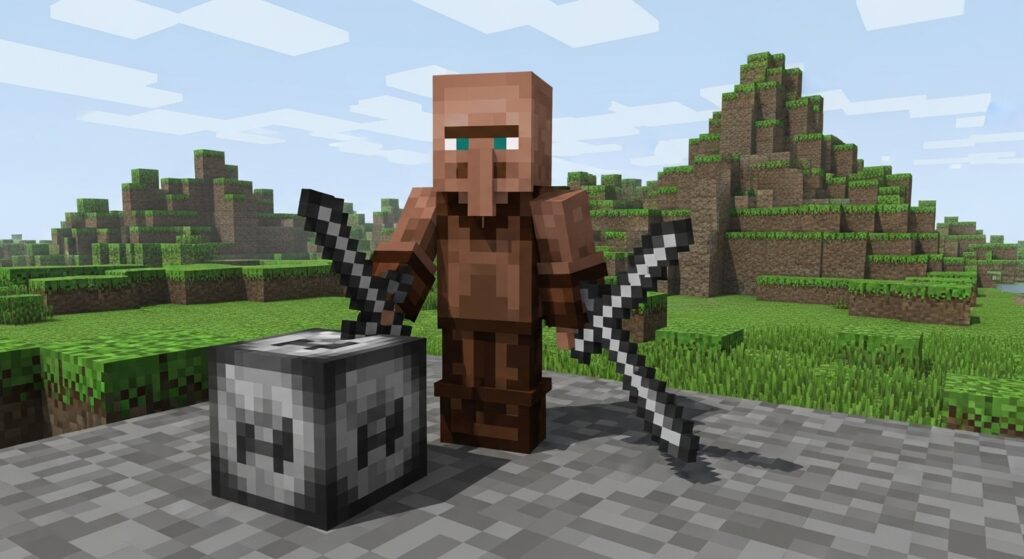
How to Use a Grindstone (Without Overcomplicating It)
A grindstone’s interface is easy:
- Two slots at the top
- One output slot at the right
You put:
- Same-type items (e.g., two iron swords): they merge durability
- Enchanted item: enchantments get wiped
- Any damaged item: small XP refund
And honestly? That XP refund feels like free money. Not much, but if you’ve been running around with weird loot from dungeons or end cities, you can cash out a whole pile of “meh” enchantments.
Grindstone Repair and Disenchant
This is where the grindstone shines:
- Repair: Combine two damaged items → one stronger item.
- Disenchant: Removes enchantments (except curses).
- XP Return: Gives experience equal to the value of the enchant.
Think of it as taking a salvage pile and scrubbing it clean.
Grindstone Uses That Players Forget About
Some players treat the grindstone like an old broom hidden in the corner, only pulled out when your sword looks sad. But there’s more to it.
✔ 1. Reset Enchanted Books (Indirectly)
Not directly, but if you cycle villagers, you can remove their job (break grindstone) and reset trades.
✔ 2. Clean Up Loot Chests
Strongholds, dungeons, temples, bastions, they’re full of enchanted garbage. The grindstone turns them into XP.
✔ 3. Save Your Anvil Durability
Every time you use an anvil, it has a chance to break. Grindstone doesn’t.
✔ 4. Prep Items for Rebranding
Meaning: wipe bad enchants so you can apply new ones.

Minecraft Anvil vs Grindstone: The Real Difference
People mix these up all the time even though they behave totally differently.
Table: Anvil vs Grindstone
| Feature | Anvil | Grindstone |
| Enchantment Application | Yes | No |
| Disenchanting | No | Yes |
| Combining Items | Yes | Yes |
| XP Cost | Yes | No (gives XP) |
| Durability | Breaks over time | Never breaks |
| Rename Items | Yes | No |
If you’re deciding which to build first, go with the grindstone. It’s cheaper, easier, and honestly feels like a survival essential.
Wood and Stone Recipes in Minecraft (Why This Matters Here)
This might feel like a tangent, but wood and stone recipes in Minecraft are actually connected to grindstone crafting more than people think.
Because grindstones require:
- processed wood (sticks + planks)
- processed stone (smelted cobble)
So you’re essentially combining two beginner-tier crafting trees.
If you’ve just spawned in a new world, you can craft a grindstone by Day 1 as long as you’ve got a furnace running. It’s one of those items that looks mid-game on paper but is actually early-game friendly.
Grindstone Troubleshooting: Why Isn’t It Working?
A few issues beginners hit:
“The recipe isn’t showing up.”
- You may be using cobblestone slab instead of stone slab.
“It’s not repairing my items.”
- Items must match type/material.
(Iron sword + iron sword = okay. Iron sword + stone sword = nope.)
“I’m not getting XP when disenchanting.”
- Items with Curse of Binding or Curse of Vanishing don’t refund XP.
“My villagers won’t change professions.”
- Villagers with trades locked cannot change jobs.
- Grindstone must be accessible (not blocked).
Grindstone Guide for Beginners
If someone wanted a grindstone guide in one breath, it would look like this:
- Gather sticks, planks, stone slab
- Craft grindstone using the 3×3 grid
- Place it near your crafting and storage area
- Use it to repair tools, merge items, and remove enchantments
- Cash out XP from junk enchanted items
- Don’t use it on cursed items unless you just want them clean but curse-intact
That’s the gist, and probably 90% of what most players need day-to-day.
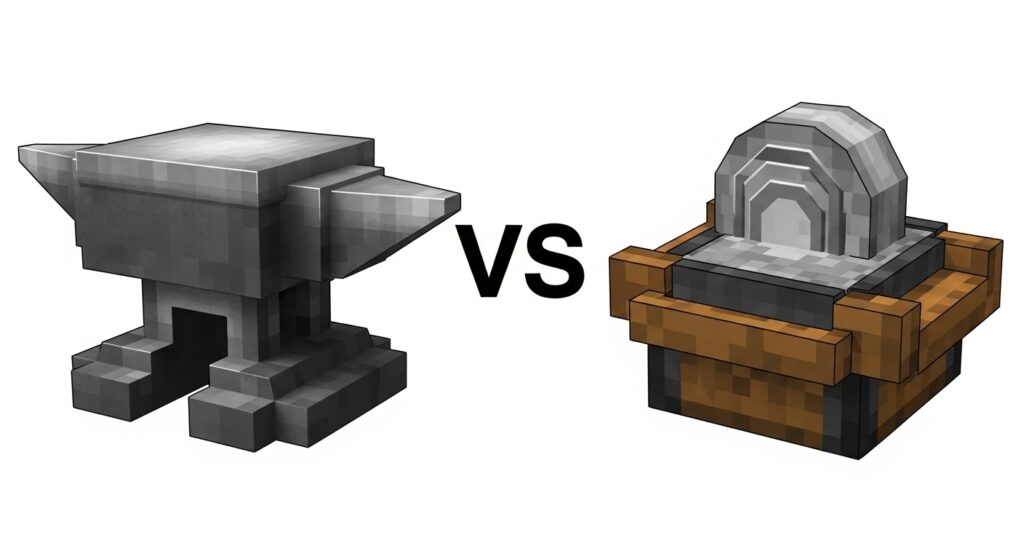
The Reality of Early-Game vs Late-Game Grindstone Use
Honestly, the grindstone shows up at every stage of a Minecraft world, whether you’re living in a dirt hut with a torch on a fencepost, or you’ve built a megabase with redstone doors that nobody asked for.
Early Game:
- You use it to merge damaged wooden or stone tools
- Maybe wipe an enchant off a book you don’t like
- And that XP… you’ll take every orb you can get
Mid Game:
- Loot starts piling up
- You hit abandoned mineshafts, desert temples, nether structures
- Every chest drops some half-useless enchanted tool
- The grindstone becomes your “recycling bin” for free XP
Late Game:
- It becomes part of your workstation setup
- You start optimizing villagers
- You realize XP from disenchanting can be stacked pretty fast
- And you use the grindstone to clear gear before re-enchanting properly
It fits into every stage because it doesn’t really “age out.” Even when you’re wearing full netherite and flying around with mending on everything, you’ll still want it nearby.
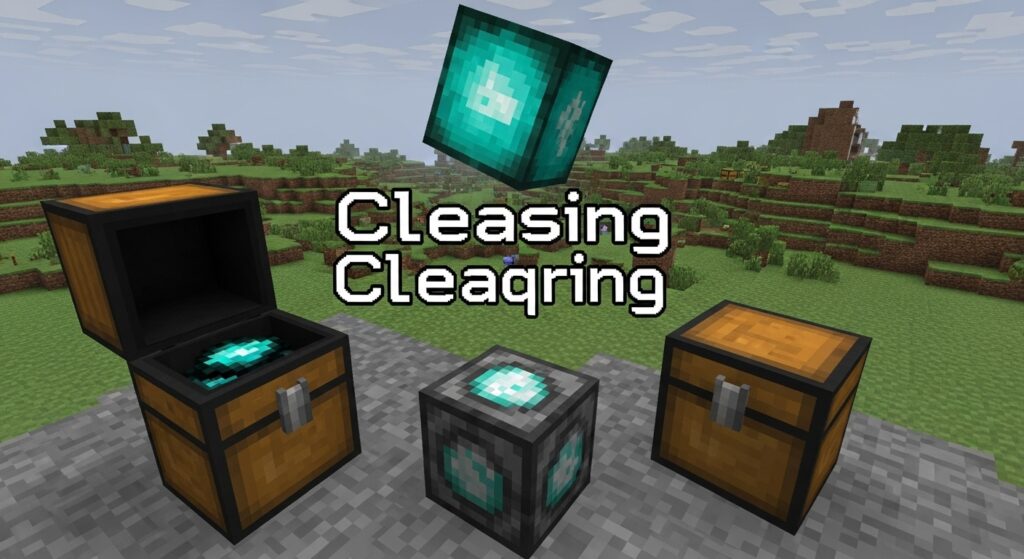
Enchantment Theory (The Part Players Skip Until They Don’t)
Let’s dig into something people skip: why disenchanting matters.
If you think about enchantments in Minecraft, you usually want:
- Efficiency
- Unbreaking
- Sharpness
- Fortune
- Mending
But the game throws enchantments at you like random loot boxes. You get Bane of Arthropods when all you wanted was Sharpness. Or Fire Protection 2 on an iron helmet that you’ll never use.
That’s where the grindstone basically lets you recycle enchantments into XP. You’ll probably never use the enchant, but hey, XP is XP.
And small tip: the higher-level the enchantments, the more XP you get back. This means structures like Strongholds, End Cities, and Bastions turn into literal XP farms if you grindstone everything.
Crafting Table Recipes That Pair Well With the Grindstone
The grindstone connects to a weird little ecosystem of items you’ll end up crafting. Some of these are so common they’re basically muscle memory.
Recipes you tend to craft alongside grindstones:
- Furnace: smelt cobblestone
- Stonecutter: for processed stone projects
- Anvil: for enchantment combining
- Smithing Table: netherite upgrading
- Chest: storage for all the stuff you’ll disenchant
The grindstone kind of anchors your early workshop setup. It’s the thing most people build right next to their crafting table and furnace without even thinking about it.

Advanced Grindstone Uses Most Players Forget About
This is where things get interesting. Everyone knows the basics, but the grindstone has some less obvious tricks.
1. XP Farming From Raids:
Raid mobs drop so much gear that isn’t worth using, but when you disenchant it all? Huge XP wave.
2. Clearing Fishing Rod Junk:
AFK fish farms (in older versions) threw tons of enchanted rods at you. Grindstone cleans them fast.
3. Flattening Gear for Custom Builds:
If you want to rename or re-enchant gear later, wiping enchants first avoids stacking penalties.
4. Resetting Villager Professions:
Break the grindstone: Villager loses Weaponsmith job
Place it back: They reroll trades
Super handy if you’re cycling for that perfect diamond sword trade.
5. Repairing Without Using the Anvil:
Since anvils break eventually, the grindstone is your “free repair” option for combining items.
Common Mistakes Players Make With Grindstones
The grindstone is simple, but Minecraft always finds a way to trip people up.
Mistake 1: Trying to remove curses:
Curses don’t come off. The grindstone ignores them entirely.
Mistake 2: Thinking you can apply enchantments:
Nope. That’s the anvil’s job.
Mistake 3: Using the wrong slab:
Cobblestone slabs don’t work.
Smooth stone slabs don’t work either.
You need regular stone slabs.
Mistake 4: Combining high-value tools:
If two enchanted items both have good enchants, the grindstone will remove all enchantments. There’s no partial removal.
Mistake 5: Expecting big XP every time:
Weak enchants = weak XP refund.
Nothing wrong with that, just don’t expect to level up from wiping Efficiency II off a random gold sword.

Tiny Details People Overlook About Grindstones
Just some small but good-to-know facts that don’t get talked about enough:
Grindstones are fireproof:
You can throw them in lava and they won’t burn.
They can be waterlogged:
Looks weird, but yeah—grindstone underwater.
Villagers detect them instantly:
If you place one in a village, a Weaponsmith spawns faster than you can blink.
They make decent decorations:
People use them for supports, wheel props, medieval details, even lamp posts.
Grindstones cannot be pushed by pistons:
Don’t ask how I found that out.
They emit the tiniest bit of light when interacted with:
Blink-and-you’ll-miss-it kind of detail.
Grinding for XP (Literally)
So let’s talk about XP farming with grindstones, because this is probably the most overlooked method of leveling.
If you’ve ever raided:
- Woodland mansions
- Nether bastions
- End cities
- Pillager outposts
- Strongholds
You’ve probably been overwhelmed by enchanted gear.
Here’s the trick:
- Dump it all in a chest
- Sort it (ish)
- Grindstone everything that isn’t rare
- Watch your XP bar jump like crazy
It’s not as flashy as mob farms or enderman grinders, but it’s practically free XP if you explore a lot.
The Grindstone in a Redstone World
Technically, grindstones don’t have redstone functionality. But they do something funny when you interact with them, they update nearby redstone, kind of like opening a chest.
So players use them in:
- Hidden doors
- Item-detection systems
- Secret base entrances
If you want your base to look “normal” while still having secret interactions, a grindstone as a trigger mechanism actually works.
Not game-changing. Just clever.
Building Workstations That Flow (Aesthetic Tip)
You’ll thank yourself later if you put your grindstone in a spot that makes sense. Most players group it with:
- crafting table
- furnace/blast furnace
- anvil
- enchanting area
- storage
- stonecutter
- smithing table
You end up with this little crafting corner that feels functional without being fancy. It becomes second nature to walk in, fix your tools, wipe an enchant, smelt some ore, and move on.
Some people like symmetry. Some like clutter. The grindstone fits into both.
Quick Reference Table (Everything in One Place)
Grindstone Overview Table
| Topic | Summary |
| Grindstone Materials Needed | 2 sticks, 2 planks, 1 stone slab |
| Placement | Directional, villager job-site block |
| Uses | Repair, disenchant, XP refund |
| Villager Role | Creates Weaponsmith |
| Ingredient Tip | Stone slab must come from smelted stone |
| XP Interaction | Gives XP when wiping enchants |
| Limitations | Cannot remove curses; cannot apply enchantments |
FAQs (From Google “People Also Ask”)
Q1: How do you make a grindstone in Minecraft?
The items you need are 2 sticks, 2 wooden planks, and 1 stone slab. All these should be placed in a crafting table as follows: sticks should be placed at the two top corners, a stone slab in the center top, wooden planks in the middle left and middle right.
Q2: What is the use of a grindstone in Minecraft?
One of the uses a grindstone has in Minecraft is to make a tool as good as new by combining two tools, to de, enchant the tools and also to give the player back XP depending on the level of the de, enchanting.
Q3: Are grindstones able to take off curse enchantments?
Impossible. Curses such as the Curse of Binding or the Curse of Vanishing keep being there even if you remove other enchantments.
Q4: How do villagers interact with a grindstone?
An unemployed villager turning a look at a grindstone will be a Weaponsmith as a result. The process of trade rerolling is done by breaking and replacing the grindstone until you get the trades that you want.
Q5: What differ a grindstone from an anvil?
Anvils are used to put enchantments on items, to combine enchanted books, to give a new name to items, and to charge the player with XP. Meanwhile, grindstones can only get rid of enchantments, merge the two instances of an item that is damaged without charging you, and grant XP instead of taking it.
One Last Bit Before We Wrap This Up
I could keep going, Minecraft has a weird way of making even the simplest block feel like it has a dozen quirks, but you’ve got everything you need here. You know how to craft a grindstone, how to place it, how to use it, how it compares to an anvil, and all the little troubleshooting things that catch people off guard.
If you build a fresh world or a massive base, this thing’s going to sit somewhere near your crafting table whether you planned it or not. It’s just one of those blocks that quietly becomes part of your workflow.
Anyway, That’s pretty much the whole story… and the grindstone does its job without asking for attention.
So yeah, have fun grinding (in Minecraft, obviously).
That’s about it. Let it taper off here.

Thomas Hill: Your guide to epic adventures. I cover RPG Reviews, Walkthroughs, Game Lore, and Open World Rankings. Ready for your next quest?

